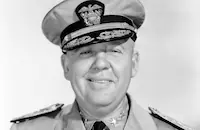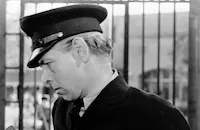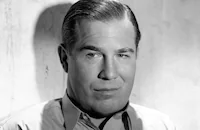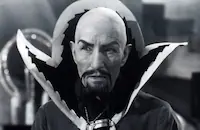The Sign of the Cross
Brief Synopsis
Cast & Crew
Cecil B. De Mille
Fredric March
Elissa Landi
Claudette Colbert
Charles Laughton
Ian Keith
Photos & Videos
Film Details
Technical Specs

Synopsis
In Rome in the year 66 A.D., hedonistic Emperor Nero burns the city of Rome and blames it on the Christians, who threaten his belief that he is the master of the world. When Titus, an elderly apostle of Christ, arrives in Rome to deliver St. Paul's message, he draws half of the sign of the cross in the sand, to which the Roman Flavius responds with the other half, after which they are arrested. Marcus Superbus, the prefect of Rome, intervenes and pardons them at the request of Mercia, a beautiful and virtuous Christian woman. Then Dacia, a courtier, reports to the Empress Poppaea, who is in love with Marcus, that he has fallen for a Christian. Tigellinus, who is Marcus' rival for Nero's devotion, sees his chance to prove that Marcus is disloyal by arresting the very Christians Marcus has pardoned. That evening, when Mercia sends young Stephanus to fetch the bread for dinner, Tigellinus arrests and tortures him to confess the whereabouts of the secret Christian meeting. Stephanus faints, however, before he can name Mercia a Christian. Marcus learns of the arrest and nurses Stephanus' wounds, then leaves with troops to stop Tigellinus. Poppaea orders Marcus to come to her, however, and he is detained as Tigellinus' men attack the Christians with arrows. By the time Marcus arrives at the meeting, both Titus and Flavius have been killed. Marcus commands the troops to end the massacre and rescues Mercia, ordering that those still alive be taken to prison. Mercia is brought to the palace that night and Poppaea, determined to make Marcus forget Mercia, swears her love to him. Tigellinus then convinces Nero to make an example of Marcus by executing him for treason, but Poppaea intervenes, insisting his motives are not religious, but sexual. She then orders that Mercia be taken from him. Marcus, meanwhile, proposes to Mercia, but when she accuses him of wanting her only as his sexual slave, he curses her Christianity. Later, during a palace orgy, Marcus mocks Mercia's virtue by having the court temptress Ancaria perform a lascivious dance for Mercia in a futile attempt to arouse her. Meanwhile, outside the palace, the Christians sing a dirge as they are led to the prison. The eerie music frightens Ancaria, and she is unable to continue dancing, and Marcus is forced to end the orgy. Mercia then explains that Marcus' love cannot out-power Christian truth, and he nearly forces himself on her, but Tigellinus interrupts with an order for her arrest. Marcus, in a rage, begs Nero to spare Mercia, but Poppaea insists Mercia be killed. The next day, thousands of Romans gather at the arena to witness the execution of one hundred Christians by lions, as well as a host of bloody spectacles planned by Nero to please the blood-thirsty crowd. As the barbaric audience cheers and makes wagers, gladiators kill each other, African pygmies fight half-naked amazon women to the death, and men wrestle wild beasts. The orgy continues as tigers devour maidens and gorillas and naked girls are tied to posts. Finally, the Christians are led, praying, out of the dungeon and into the arena. When Stephanus becomes paralyzed with fear, Mercia promises to meet him in heaven. Marcus arrives moments before Mercia walks up the steps to the arena, begging her to renounce her faith so that she might live. He admits he prayed the night before, and she swears her love, promising to teach him the Christian faith. Suddenly he is full of strange hope and is willing to die in order to have her as his wife in heaven. As Marcus and Mercia walk to their death, the dungeon doors close, creating the shadow of the sign of the cross.

Director

Cecil B. De Mille
Cast

Fredric March

Elissa Landi

Claudette Colbert

Charles Laughton

Ian Keith

Arthur Hohl
Harry Beresford
Tommy Conlon
Ferdinand Gottschalk
Vivian Tobin

William V. Mong
Joyzelle [joyner]
Richard Alexander

Nat Pendleton
Clarence Burton
Harold Healy
Robert Manning

Charles Middleton
Joseph Bonomo
Ynez Seabury
Lillian Leighton
Otto Lederer
Lane Chandler

Wilfred Lucas
Jerome Storm
Florence Turner
Gertrude Norman
Horace B. Carpenter
Carol Holloway

Wynne Gibson
Crew
Anne Bauchens
Sidney Buchman
Sidney Buchman
Cecil B. De Mille
Nat Finston
Rudolph Kopp
Rudolph Kopp
Mitchell Leisen
Harry M. Lindgren
Eddie Salven
Karl Struss
Waldemar Young

Photo Collections
Film Details
Technical Specs

Award Nominations
Best Cinematography
Articles
The Sign of the Cross
After a dozen years at Paramount, DeMille had gone independent in 1925. But independence wasn't profitable, and DeMille had signed a three-picture deal with MGM in the early talkie period. When those films proved unsuccessful, the director went back to Paramount, with a contract for one film only: The Sign of the Cross. The Depression was in full swing, and the studio would not tolerate DeMille's old free-spending ways. He had just $650,000 to make his epic about the mad emperor Nero, his libidinous wife, and a Roman prefect in love with a Christian girl.
DeMille set about re-assembling his old crew: production and costume designer Mitchell Leisen, editor Anne Bauchens, and assistant director Roy Burns, all at greatly reduced salaries. To save money, Leisen devised a series of miniatures and mattes in place of sets, with characters entering them through a series of full-sized ramps and steps. They had to shoot precisely head-on, because there was nothing on either side. For crowd scenes, cinematographer Karl Struss used prism lenses to make it appear as if there were twice the number of extras. Finally, in the middle of a take, Burns whispered to DeMille that all the money had been used up. The director yelled "Cut!" wrapped production, and told Bauchens to start cutting the film. Somehow, she managed to make it all work with the film that had been shot.
The need to economize did nothing to temper DeMille's showmanship, however. Lions, tigers, bears, and elephants were rented from a dozen zoos. But even though they were trained animals, they either refused to cooperate or cooperated too well. For a scene where lions were supposed to attack the Christians, Leisen and his crew had stuffed dummies with lamb carcasses, but the lions wouldn't eat them. They merely lapped daintily at the blood. The elephants were supposed to parade slowly around the arena. But when they heard the extras' applause, they reacted as they'd been taught to do, by standing on their heads.
DeMille's eye for talent gave a boost to the careers of two actors in The Sign of the Cross. Before production began, DeMille had been in London and had seen Charles Laughton in a play. Although Laughton was unknown in the United States, DeMille thought he would be perfect to play Nero, and brought him to Hollywood, where The Sign of the Cross became Laughton's first American film.
While on the Paramount lot, DeMille noticed a young contract actress, Claudette Colbert, whose films he called "fluffy, lightheaded stuff." The director approached her and asked, "how would you like to play the wickedest woman in the world?" "I'd love it!" Colbert replied, and she played the empress, wonderfully. But it wasn't always easy. The famous scene in which Poppaea bathes in asses' milk took several days to shoot. DeMille, of course, announced to the press that real asses' milk was being used, though it was probably powdered cow's milk. The milk was left standing in the tub overnight, and by the second day, it had turned to cheese under the hot lights. The stench was overwhelming. Colbert nearly fainted from the odor.
Lions devouring Christians, nudity, homosexuality, orgies, murder...there was plenty for even the weakest censors to object to in The Sign of the Cross. But DeMille refused to make cuts, and as he had done so often in the past, he prevailed. Like most of DeMille's biblical epics, The Sign of the Cross was a big, brash, vulgar hit, even in the depths of the Depression. DeMille was back on top, and he would remain at Paramount for the rest of his life and career.
Producer/Director: Cecil B. DeMille
Screenplay: Waldemar Young, Sidney Buchman, based on the play by Wilson Barrett
Cinematography: Karl Struss
Editor: Anne Bauchens
Art Direction/Costume Design: Mitchell Leisen
Music: Rudolph G. Kopp
Principal Cast: Fredric March (Marcus Superbus), Elissa Landi (Mercia), Claudette Colbert (Poppaea), Charles Laughton (Nero), Ian Keith (Tigellinus), Vivian Tobin (Dacia), Harry Beresford (Favius), Joyzelle Joyner (Ancaria).
BW-125m. Closed captioning.
by Margarita Landazuri

The Sign of the Cross
Quotes
Take off your clothes and get in here!- Poppaea
...the food, the wine, the delicious debauchery!- Nero
Trivia
Third film in Cecil B. DeMille's biblical trilogy, following Ten Commandments, The (1923) and King of Kings, The (1927).
Originally released as a 124 minute feature. After the Hays Code was instituted, some of the more "sinful" scenes were cut for the film's re-release in 1944.
The milk bath scene took a whole week to film. Every time Claudette Colbert got out of the pool, director Cecil B. DeMille tried to catch a glimpse of her in the nude. A crew member always threw a towel over Miss Colbert beforehand, so DeMille never got a good look at his actress.
Notes
Although the film lists the copyright as Paramount Productions, Inc., copyright records list it as Paramount Publix Corp. Wilson Barrett's play was first performed as one of several productions of a theatrical tour in the U.S. in 1895, which began in St. Louis. It was first seen in England in Leeds the same year and became a sensation when it opened in London on May 27, 1895. Barrett was famous for his portrayal of Marcus Superbus on the stage. Paramount demanded thirty-five percent of the gross receipts from renters for this film.
DeMille made a personal appearance at the Boston premiere and travelled to the east coast on November 14, 1932 to assist in the studio campaign to get this picture through official censor boards without deletions. On December 10, 1932, Motion Picture Herald reported, however, that prior to the film's release, three or four minutes of screen time were cut in which Marcus becomes "the immobile focus of a bombardment of Lesbian wiles offered by a dancing wanton." After early screenings in New York, Motion Picture Herald reported, an "entrancingly sadistic passage limning the approach of a herd of hungry crocodiles waddling to an arena feast of edible, white fleshed Christian girls" was also cut. Motion Picture Herald stated that audiences would love the film "provided their sensibilities survive the odors of Lesbos and de Sade." According to the film's file in the MPAA/PCA Collection at the AMPAS Library, the Hays Office wanted Ancaria's seductive dance around Mercia eliminated entirely. In his autobiography, DeMille recounts the conversation he had with Hays Office director Will H. Hays regarding the scene. After Hays asked DeMille what he was going to do about the scene, DeMille responded, "Not a damn thing." The dance stayed in the picture. A MPPDA memo outlines scenes cut by the Singapore censors, which include: trucks carrying dead bodies, a gorilla dancing around a nude girl and elephants walking over Christians and picking them up with their tusks, all of which were not in the viewed print. In July 1932, Alfred Cohen, president of B'nai Brith of Cincinnati, wrote to Carl E. Millikin of the Hays Office protesting the making of this film, which he claimed was highly offensive to Jewish people. Jason Joy, also of the Hays Office, assured Milliken that there was no basis for Cohen's apprehension concerning anti-semitic propaganda, and the matter apparently was dropped. According to a Film Daily news item on February 27, 1935, a dubbed version of Sign of the Cross opened in Venice, Italy on March 2, 1935. According to Film Daily, this film was the first offering under a contract closed with Paramount by Clement Giglio, an Italian-American impresario, who would henceforth handle Paramount's Italian releases. For his work on the picture, cinematographer Karl Struss received an Academy Award nomination.
Variety reported that during World War II, because of the Allied campaign in Italy, DeMille recommended that this film be re-issued with a prologue uniting the themes of Nero and Adolf Hitler's dictatorships. Prologue production was completed March 25, 1944 and reportedly cost $100,000-125,000. The re-issue came out in 1944, with a prologue lasting 8 1/2-11 minutes, according to various contemporary sources. While Nazi forces occupied Rome, the studio rushed marketing of the re-issue, which was released December 1, 1944. According to a memo in the Code file, the 1944 version received a certificate of approval after a shot of "a robe falling out of scene, presumably leaving [a] woman naked," was deleted. Mitchell Leisen was the art director for the prologue, which was written by Dudley Nichols. The cast for the prologue was as follows: Stanley Ridges (Thomas Lloyd), Arthur Shields (James Costello), Tom Tully (Hoboken), James Millican (Capt. Kevin Driscoll), Oliver Thorndike (Lt. Robert Hammond), William Forrest (Colonel Hugh Mason), John James (Lt. Herb Hanson) and Joel Allen (Bombardier). The prologue takes place in the present of 1944. An American B-17 bomber drops propaganda leaflets over the eternal city to inform Roman citizens that the Allies will be bombing only military stations. As they fly over Rome, two chaplains, a Protestant (Lloyd) and a Catholic (Costello), reminisce about ancient Rome and Nero's persecution of tens of thousands of Christians. Parallels are drawn between Nero and Hitler. The final shot of the prologue is of four planes flying off into the distance. A short epilogue shows the American bombers heading back to North Africa-mission accomplished. In 1944, New York Times reported that there was talk of Paramount re-editing the original Roman bath scene in which Empress Poppaea (Colbert) is immersed in 500 gallons of wild asses milk. In the original version, the cameras caught a glimpse of Colbert's breast as she bathes. In the scene, two kittens are shown drinking from the bath, and press material states that the kittens were added to show the authenticity of the milk bath. By April 2, 1944, it was decided DeMille could keep his bath scene. The New York Times reported on April 2, 1944 that some scenes were omitted from the first version to fit the prologue, but it is unclear which scenes were cut.
In November 1932, Motion Picture Magazine published an article about DeMille "defying the Depression" by hiring 4,500 extras for this film. The article said that half of the Sign of the Cross extras worked with DeMille on The Ten Commandments; and nearly two-thirds on The King of Kings. DeMille reportedly preserved old lists of extras. His casting directors faithfully called every actor on the list before hiring new people. In reference to the hungry actors who hoped for a part in this film, DeMille is reported as having said: "It was heart-breaking...they'd lie in wait for me wherever I went...I don't suppose anyone in Hollywood has heard as many hard-luck stories as I have these last months." Wynne Gibson reportedly walked onto the Sign of the Cross set and DeMille cast her as a lady in audience at the Roman orgy. According to DeMille's autobiography, this film's general release took place during the "Bank Holiday" in the height of the Depression, when every bank in the country was closed in order to prevent a catastrophic collapse of the entire banking system. As a result of a nationwide dearth of cash, DeMille writes, motion picture theater managers accepted "unsecured I.O.U.'s scribbled on little pieces of paper," as admission to this film. Nearly every one of them was redeemed, DeMille reports, when cash began to flow again.
According to a modern source, Mitchell Leisen acted as assistant director and art director on this film, as well as handling costumes, for which he received credit on the viewed print. Modern sources state that John Carradine was in the cast. A British film version of Barrett's play was made in 1904, directed by William Haggar and starring Will Haggar, Jr. and Jenny Linden. Famous Players Film Co. made a film version of the play in 1914, directed by Frederick Thomson and starred William Farnum and Rosina Henley (see AFI Catalog of Feature Films, 1911-20; F1.4006). Paramount re-released the 1932 DeMille version on February 9, 1934 and re-issued it in June 1938. Portions of this film were used in the religious documentary Through the Centuries (see below).














